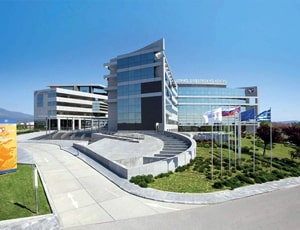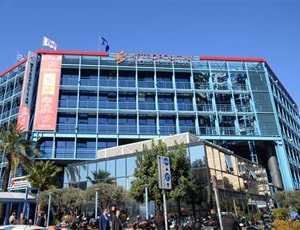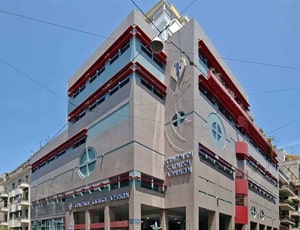The average cost of Brachial Plexus Injuries/Stereotactic Procedures in Thessaloniki approximately starts from USD 34000
Treatment cost

Apart from in-detail treatment procedures available, Medical Inter-Balkan Thessaloniki located in Thessaloniki, Greece has a wide variety of facilities available for International Patients. Some of the facilities which are provided by them are Accommodation, Airport Transfer, Choice of Meals, Interpreter, SIM, TV inside room. Also listed below are some of the most prominent infrastructural details:


Apart from in-detail treatment procedures available, Metropolitan Hospital located in Pireas, Greece has a wide variety of facilities available for International Patients. Some of the facilities which are provided by them are Accommodation, Airport Transfer, Choice of Meals, Interpreter, SIM, TV inside room. Also listed below are some of the most prominent infrastructural details:

Central Clinic of Athens located in Athens, Greece is accredited by ISO. Also listed below are some of the most prominent infrastructural details:
Brachial plexus injury is a medical emergency caused due to an injury to the brachial plexus group of nerves that sends signals from your spine to your shoulder, arm, and hand. These nerves control and administer feelings in the muscles of the shoulder, elbow, wrist, hand, and arm. This damage is also known as brachial plexopathy. Brachial plexus injury appears when these nerves are compressed, stretched, or in the most serious case, ripped apart from the spinal cord. Some brachial plexus injuries known as stingers or burners are inconsequential and will completely recover in a few weeks. However, other brachial plexus injuries are severe enough and may cause some permanent impairment in the arm. In severe conditions, it can paralyze your arm, with a failure of function and sensation.
Brachial plexus injury results when the brachial nerves are damaged by excessive stretching, pressure, or cutting. Stretching can occur when your shoulder is forced down while your neck stretches up and away from the injured shoulder such as during a motorcycle or a car accident. In case of a serious injury, the brachial nerve may rip off the spinal cord in the neck. This type of brachial plexus injury is classified as a traumatic brachial plexus injury. It may occur because of different reasons, including:
Brachial plexopathy may also result from exposure to radiation at the time of stereotactic radiosurgery or specific procedures such as stereotactic breast biopsy.
Symptoms of the brachial plexus injury depend on the seriousness of the injury. A minor injury can often occur during any contact sport and minor trauma when the brachial plexus nerves get stretched or compressed. Minor brachial plexus injury symptoms include the following:
More serious brachial plexus injury symptoms result when nerves are torn or ruptured. Such injuries may produce the following symptoms:
In case of childbirth brachial plexus injury, symptoms can be seen right after the birth of the child. These may include:
Some common types of surgical brachial plexus injury treatment include the following:
It is very hard to assess an exact recovery time after brachial plexus injury treatment due to the broad spectrum. How likely a spontaneous recovery depends on the type and severity of the injury.
In the case of surgery, nerve tissue grows very slowly, about an inch a month, so it can take a few years to assess the success of brachial plexus injury surgery. However, during the recovery period, patients are encouraged to keep their joints flexible by following an exercise schedule. The success rate of surgery is quite good but recovery time and success rate must be assessed on an individual basis.
Ask your healthcare adviser for the best multiple options and choose the one that meets your expectations
On an average, Brachial Plexus Injuries/Stereotactic Procedures in Thessaloniki costs about $34000. Many multispeciality hospitals in Thessaloniki that are JCI certified are approved and most sought after for treating international patients with Brachial Plexus Injuries/Stereotactic Procedures.
Brachial Plexus Injuries/Stereotactic Procedures cost in Thessaloniki varies from one hospital to the other. The top hospitals for Brachial Plexus Injuries/Stereotactic Procedures in Thessaloniki covers all the expenses related to the pre-surgery investigations of the candidate. The comprehensive Brachial Plexus Injuries/Stereotactic Procedures package cost includes the cost of investigations, surgery, medicines and consumables. Extended hospital stay, complications after the surgery or new diagnosis may affect the overall cost of Brachial Plexus Injuries/Stereotactic Procedures in Thessaloniki.
There are many hospitals across the country that offer Brachial Plexus Injuries/Stereotactic Procedures to international patients. The top hospitals for Brachial Plexus Injuries/Stereotactic Procedures in Thessaloniki include the following:
After Brachial Plexus Injuries/Stereotactic Procedures in Thessaloniki, the patient is supposed to stay in guest house for another 15 days. During this time, the patient undergoes medical tests and consultations. this is to ensure that the treatment was successful and the patient us safe to return.
Thessaloniki is undoubtedly one of the best cities for Brachial Plexus Injuries/Stereotactic Procedures in the world. It offers the best medical expertise and good patient experience at an affordable cost. Some of the other destinations that are popular for Brachial Plexus Injuries/Stereotactic Procedures include the following:
There are certain additional cost that the patient has to pay apart from the Brachial Plexus Injuries/Stereotactic Procedures cost. These include the cost of accommodation and meals outside hospital. The per day cost in this case may range from 50 USD.
After the Brachial Plexus Injuries/Stereotactic Procedures surgery takes place, the average duration of stay at the hospital is about 3 Days. The patient is subjected to several biochemistry and radiological scans to see that everything is okay and the recovery is on track. After making sure that patient is clinically stable, discharge is planned.
There are more than 1 Hospitals that offer Brachial Plexus Injuries/Stereotactic Procedures in Thessaloniki. These hospitals are approved to perform the surgery and have proper infrastructure to handle Brachial Plexus Injuries/Stereotactic Procedures patients. Such hospitals follow all legal protocols and guidelines as specified by the local medical affairs body when it comes to the treatment of international patients.